The following are the CDC and the DBC’s Minimum Standards for Infection Control categories for patient care items based on the risk of infection during their use:
-
- Critical Instruments:
- These instruments are used in the patient’s mouth and come in contact with mucous membranes, blood, saliva, OPIM, and they penetrate soft tissue or bone.
- This class of instruments poses the highest risk for infection if they are contaminated with any microorganism.
- Examples include excavators, explorers, surgical instruments, scalers, endodontic instruments, bands, brackets, wires and burs, and other items used to penetrate soft tissue or bone.
- Most critical instruments are heat-tolerant and can be heat sterilized after each patient.
- Heat sensitive critical instruments must be cleaned and submerged in a high-level disinfecting solution.
- Semi-critical Instruments:
- While these instruments do not penetrate soft tissue or bone, they are used in the patient’s mouth and therefore pose a risk of infection because they come in contact with blood, saliva, and mucous membranes.
- Examples include dental mouth mirrors, amalgam carriers, x-ray film holders, dental hand pieces, and rubber dam forceps.
- Most semi-critical instruments are heat-tolerant and may therefore be cleaned and sterilized between each patient.
- Heat sensitive semi-critical instruments must be cleaned and submerged in a high-level disinfecting solution.
- Non-Critical Instruments:
- Non-critical items are instruments, devices, equipment, and surfaces that come in contact with soil, debris, saliva, blood, OPIM and intact skin, but not oral mucous membranes.
- Examples: dental chair, dental unit, x-ray heads, clinical surfaces & equipment, and curing light etc.
- These items must be protected by using the barrier method or cleaned and disinfected between each patient.
- Disposable items (single use items):
- Single use items usually come in large packages and are labeled disposable or single use.
- These should be used on just one patient and then properly disposed of in order to help reduce the chance of patient-to-patient contamination.
- Examples of disposable items (prophy cups & brushes, sterilization pouches, irrigating syringes, saliva ejectors, evacuation tips, surface barriers, face masks, exam & surgical gloves, syringe needles, suture needles, plastic orthodontic brackets.
- Critical Instruments:
